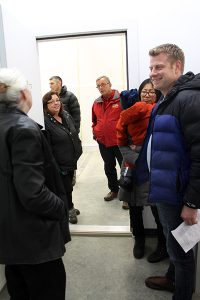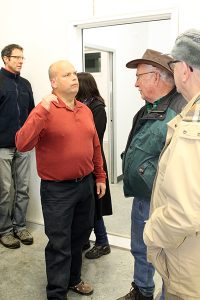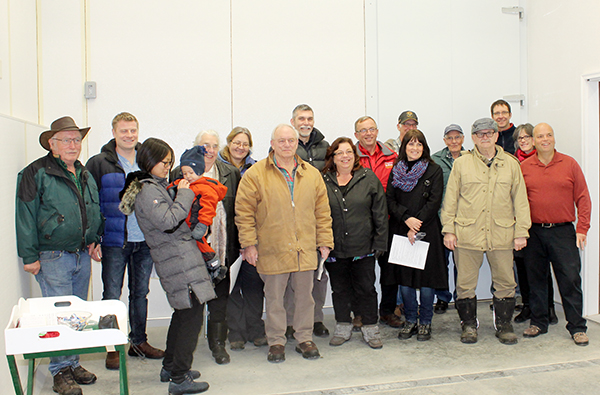Home »

Crossroads abattoir opened with VIP tour
By Stephanie Stevens
It was lights, camera, action at the December 6 tour of the much-anticipated Windermere District Farmer’s Institute (WDFI) abattoir at the crossroads to Invermere, but almost without the lights.

“This is a momentous day for us,” said Peter Trescher, who along with Hedi Trescher has been a big part of the push to get the abattoir going. “The power just came on a couple of hours ago.”
About 18 people gathered to tour the empty facility, with Hedi leading the group through each area of the building and corrals giving a comprehensive description with each stop.
Grant Kelly, owner and operator of Grant’s Foods in Invermere, will be leasing and operating the abattoir and was also on hand to answer any questions those gathered might have.
It has been a long haul to get the abattoir project going, starting back in 2006 when the WDFI formed a committee to investigate building a provincially inspected abattoir.
And Hedi, for one, is thrilled those long years have planning have finally come to fruition.
“When I plan on doing something, I get it done, though this took a while,” she said, grinning broadly. “Everything was done with local contracting, and Chris Wiegert, our general contractor, was behind this project just as much as we were.”
John Palmer of Rock-a-Boo ranch in Brisco said without Hedi, the abattoir just wouldn’t have happened.
“This is such a big advantage for farmers and ranchers,” said Palmer. “Before, after all I did to raise my animals organically, grass fed, without any steroids or antibiotics, they would be shipped to Alberta (at my expense), end up on a feed lot, branded as Alberta beef and they could do whatever they wanted to them.”
 Now, Palmer went on, his beef will be his beef, raised the way he wants it raised, and tagged electronically so the consumer will know exactly where the meat they are buying came from.
Now, Palmer went on, his beef will be his beef, raised the way he wants it raised, and tagged electronically so the consumer will know exactly where the meat they are buying came from.
“It is about accountability, and we have more control over what we produce. I am really, really happy about this.”
Alison Bell, who is with the Slow Food Columbia Valley Leadership team, said the new facility “really increases our food security as well as stability for our farming and ranching locally.
“There is no reason, for example, every golf course up and down the valley cannot be serving a local bratwurst,” said Bell. “How cool would that be?”
Bratwurst, steak, burgers… any meat product could essentially now be a local product in restaurants.
“I know there are people not comfortable with the idea of an abattoir, but let’s face it, (for those of us who are) meat eaters, this is better for the animal, there is less trucking, less stress on the animal, and you know where it came from.”

Bell also noted that at the international Slow Food Summit earlier this year, the delegates were “really impressed” with the plans for the abattoir.
Kelly echoed Bell’s comments.
“I get comfort in the fact they (animals) are not trucking for hours, penned in, crowded, stressed,” he said. “We are much more able to keep it humane this way.”
Kelly said while they can hang up to 22 cows in the cooler, there would likely never be more than four to five animals brought in to the abattoir at one time, ensuring the stress on the animal will be kept to a minimum.
“It will be a really quick process.”
As far as disposal of parts normally just tossed out, Kelly is planning to be as creative as possible.
“There are a lot of parts that can be used as pet food, other parts can be composted. I would like to see bone broth made out of the bones… I don’t want to see any bones in the landfill.”
The facility has also been designed to ensure that both domestic and wild meat can be processed at the same location, and Palmer pointed out Hedi did not cut any corners. Provincial inspectors have been part of the process from day one and the abattoir was designed to accommodate future growth.
“This will rejuvenate agriculture in the valley,” Peter said, “as well as create food security.” He added that you can bring your animal in for slaughter, and if you are not selling it commercially, you can take it home and process it yourself, unlike many other facilities.
The abattoir is slated for opening sometime in January 2017 after equipment purchases have been completed.
Lead image: A number of area political leaders, including District of Invermere Mayor Gerry Taft, Electoral Area G Director Gerry Wilkie and Village of Canal Flats Mayor Ute Juras, as well as RDEK staff and WDFI representatives took part in the Dec. 6 opening. Photos by Stephanie Stevens
e-KNOW







